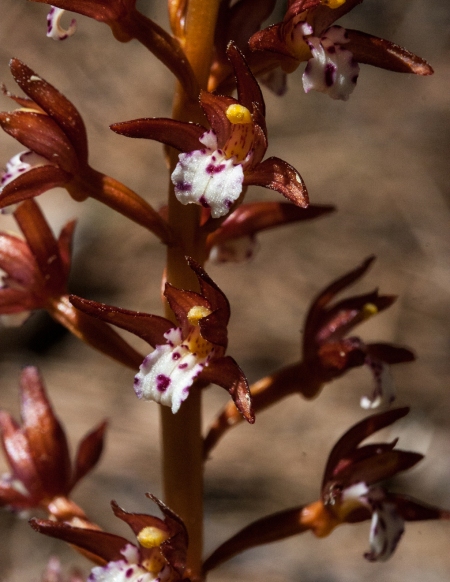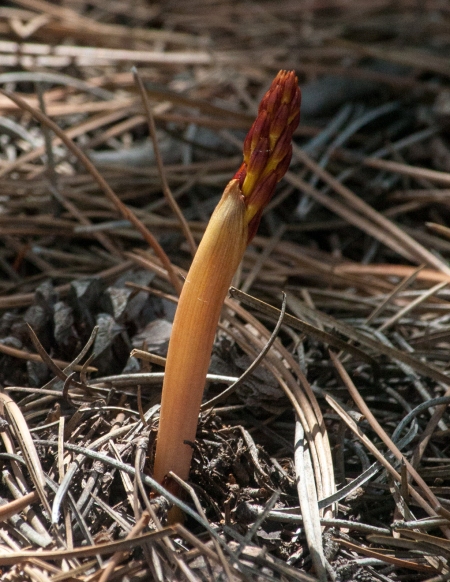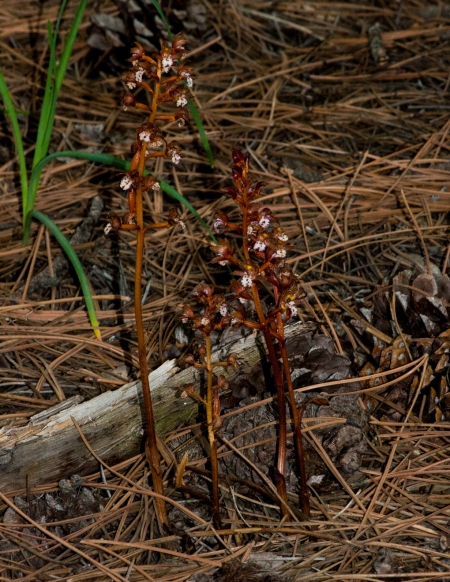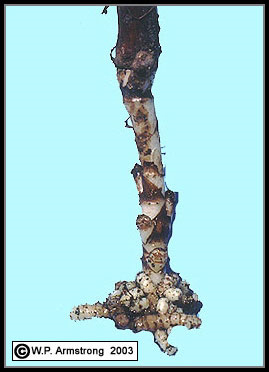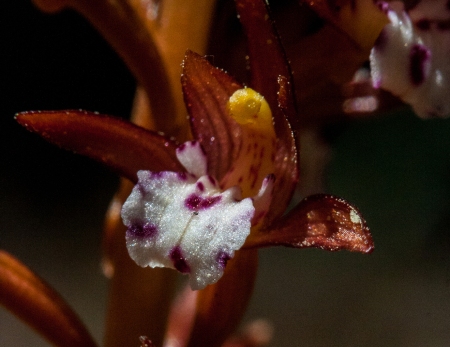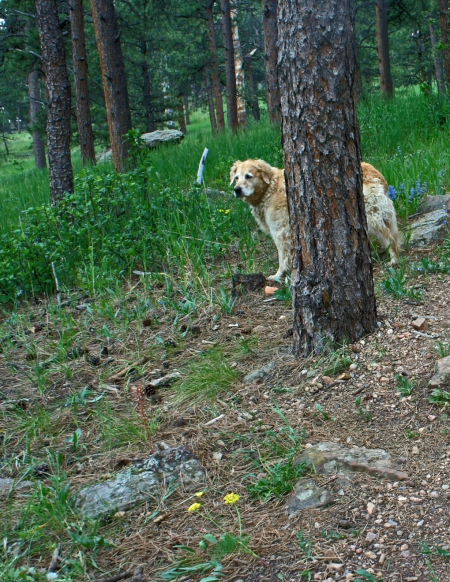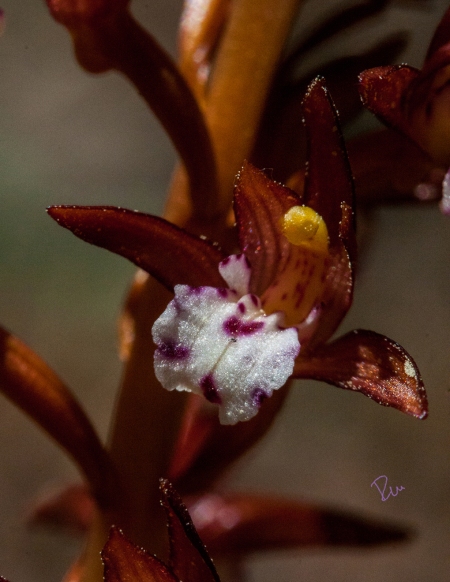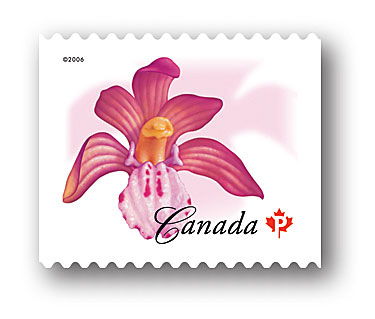“Less than the coral-root you know
That is content with the daylight low,
And has no leaves at all of its own;
Whose spotted flowers hang meanly down.”
-On Going Unnoticed by Robert Frost
While enjoying our showy spring wildflower display on the North Mesa Trail I came upon a small brown plant shyly hiding on the forest floor pine duff (partly decayed organic matter). While this Spotted Coralroot (Corallorhiza maculata) does not need to be in the spotlight its very existence is an improbable tale.
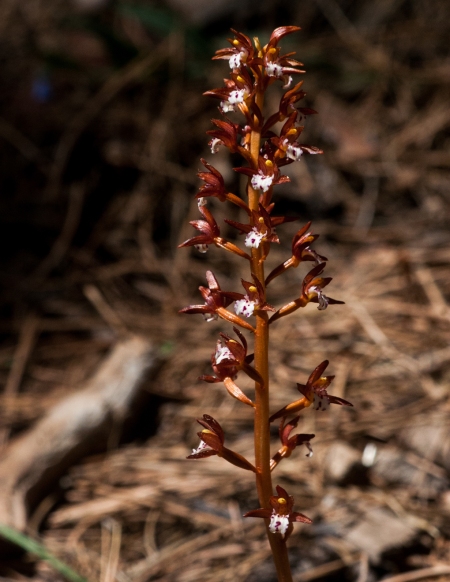
Coralroot Orchid Plant (Corallorhiza maculata) “Corallorhiza” is Greek for “coral root” and “maculata” is Latin for “spotted”
On closer inspection you can see the tiny Orchid blossoms; this is one of our tiny native Colorado Orchids…
I was surprised when I discovered my first Colorado Orchid; I thought they only grew in lush, tropical environments. Actually there are more than 25,000 species of Orchids. There are more orchids than any other kind of flowering plant except those in the aster and daisy families. Although they are most common in the tropics, Orchids can be found almost everywhere except Antarctica and the very High Arctic, occupying almost any habitat, including on other plants (epiphyte). One, known as a Western Underground Orchid, lives entirely underground. There are at least 33 types of native Orchids in Colorado (compared to only four Native Hawaiian Orchids).
Orchid seeds are too small to contain stored nutrients. To solve that problem they must be infected by a specialized fungus that establishes a symbiotic relationship, sharing food and enzymes until the young plant can survive on its own. While many plants use soil fungi as a startup strategy, some orchids have taken an evolutionary sidestep and do not use photosynthesis at all. Orchids were formerly considered to be capable of directly living off of dead organic material (saprophytic) in lieu of photosynthesis. Recent studies have revealed that plants cannot live off of dead organic material; only fungi can do that. It is now known that plants previously described as saprophytes are actually parasites living off of fungi. These fungi transfer nutrients from the host plant to the parasite (called Myco-heterotrophy). The fungi themselves are parasitic on the roots of living plants.
Our Coralroots are the type of Orchid that never becomes self-sufficient. Researchers have discovered that members of the genus Corallorhiza are parasitic Orchids. They derive all of their nutrients from mycorrhizal soil fungi in the family Russulaceae (think mushrooms). Despite their name they have no roots but only hard, branched rhizomes. The relationship with the soil fungus begins before the microscopic seed can germinate and continues for the life of the plant. Finding the right fungi to cheat for life is a chancy business and most seeds just die. To improve its survival rate the plant produces millions of seeds per flower. This is why the seeds must be small and light (the Coralroot seed is only about 0.2 mm in diameter). Those few that do go on to survive parasitize their fungi into forming a coral-like formation enveloping the root that resembles a clump of soft corals. Our pretty little Orchid is a lifelong biological cheater, cheating its fungus cheater…
In addition to the unlikely success of its seed, the complex mechanisms which orchids have evolved to achieve cross-pollination are risky as well. These mechanisms were investigated by Charles Darwin and described in his 1862 book Fertilisation of Orchids. The book was his first detailed demonstration of the power of natural selection, and explained how complex ecological relationships resulted in the coevolution of orchids and insects. The view has been expressed that the book led directly or indirectly to all modern work on coevolution and the evolution of extreme specialization.
Orchids have developed extremely specialized pollination systems often relying on a specific insect for success. The chances of being pollinated are often rare, so orchid flowers usually remain receptive for very long periods and most Orchids deliver their pollen in a single mass. When a protective cap is dislodged by a specific pollinator the pollen baring part called the anther is exposed to the insect’s body. Two pollen masses (called pollinia) are attached to a sticky pad (viscid) which readily adheres to the bodies of insects. When insects visit another orchid blossom, the pollinia are transferred to a sticky surface. Each time pollination succeeds, thousands of seeds can be fertilized.
I observed many hikers walking by this extraordinary example of evolutionary complexity without even noticing its unlikely existence…
nor its diminutive beauty…
The Canadians apparently appreciate the Corallorhiza striata (Striped Coral Root Orchid)…
